Attitudes and forms by women
The exhibition of 1969, When attitudes become form, curated by Harald Szeemann, brought together many artists but very few women. Mentalities are evolving because 50 years later the Haro sur les héros exhibition of the Wallonie-Bruxelles Centre on attitudes and forms presents only women artists.
To organize this exhibition, a jury of experts from Brussels, Liège, Namur and Paris met to select artist's creations for practices associating art with science and technology. This selection, augmented by artworks from the collection of the Brussels law firm LIME, brings together the creations of a dozen artists offering as many views on the societal issues of our time. It is clear that in this digital era, most of these same issues emerge from innovations that our collective participative practices amplify. Politically engaged, this exhibition also helps rebalance the chances of women artists.
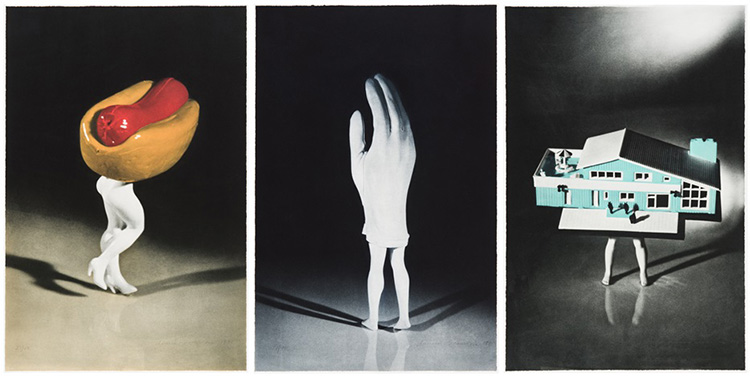
Laurie Simmons, Food Clothing Shelter, 1996.
Over the centuries, women have had to extricate themselves from the roles that were reserved for them. In art, that of model or muse and, more broadly in society, that of cook or housewife. There are artists, like Laurie Simmons, who denounce the stereotypes of a society eager for standards, the better to reproduce them. Her photographic triptych Food, Clothing, Shelter of 1996 is part of the Walking Objects series where the legs of women without bodies, hence without head or mind, support a whole range of objects. Like how so many women, for centuries - if we consider this past, past - literally 'carried' their homes. By placing clothing between food and home, it appears that it is the representation of women that is being denounced here, knowing as we do the prescribing role the communication of images has on our collective unconscious. As for the pronounced taste of this American artist for staging things, which her photographs make public, it evokes and anticipates this immoderate will that we all have today of imagining extraordinary lives through social media. Resulting at times in choosing objects from our immediate environment to represent us.
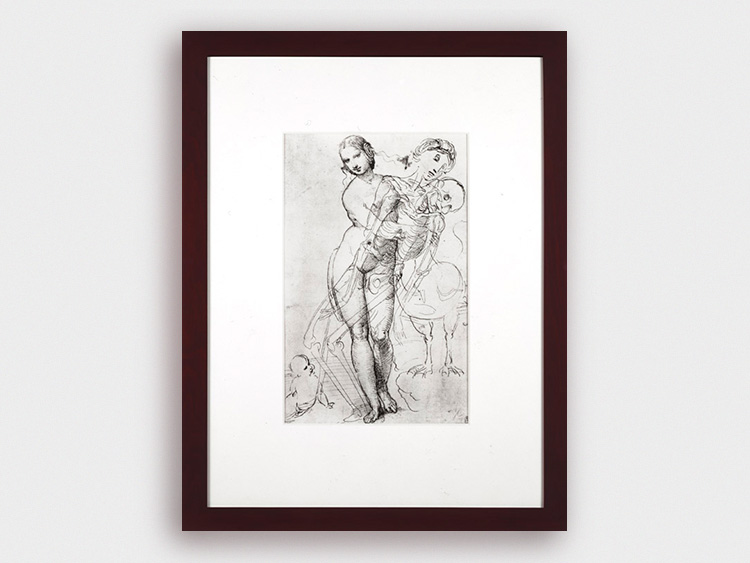
Sarah Charlesworth, Leda, Her Old Age and Death, 1991.
In Leonardo Da Vinci's drawing that Sarah Charlesworth appropriated in 1991, the focus is again the role of the model and more precisely of the female nude. In 1507, the Italian artist represented Leda alongside a swan which is none other than Zeus metamorphosed so that he could seduce her. In her appropriation of this same Renaissance drawing - Leda, Her Old Age and Death - the American artist projects Leda into the aftermath of the romantic idyll. Where, in its collapse, old age precedes death, which is a skeleton. But what end is this and what interpretation should we give it upon reading Sigmund Freud's A childhood memory of Leonardo da Vinci? What is the outcome of this relationship, sometimes going as far as the submission of the model, so often feminine, to the artist, who in the history of art has essentially been masculine? Or the end provided by stories that are built on deception, from myth to reality. If there is an end that is unannounced, it is that of appropriation that has not faltered since the craze of avant-garde artists of the 20th century who have increasingly benefited from the growth of reproduction techniques. This approach has been reinforced with the Internet, in its participatory version, where conversational images abound.
Attitudes and forms
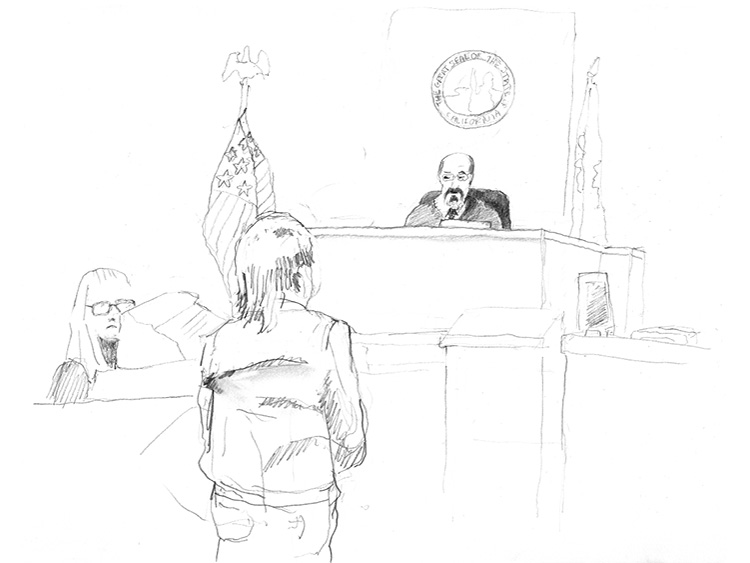
Kristin Sue Lucas, Refresh, 2007.
If there is an art movement in which attitude predominates over result, it is that of conceptual art whose works can be largely composed of documentation. This is the case of the Refresh performance of October 5th, 2007. The action, documented by a sketch and a transcript was held in the courtroom of the California Superior Court where Kristin Sue Lucas managed to change her name to the same name, Kristin Sue Lucas. The idea behind the work, as is often the case when it comes to conceptual art, is not to really change anything but rather to be reborn, even if in a resolutely similar manner. Like the page of a website whose display we refresh thinking we can make what bothered us, without knowing exactly what it was, disappear. This is, for this American, a poetic gesture inspired by our daily digital uses. She considers herself to be the "last version of herself". Refresh is also of an absolute contemporaneity in that it addresses the notion of identity. Because if presenting one's papers is to prove that one is identical to oneself, ever since this performance in the courtroom, online services where one presents oneself non-identical to oneself, even going so far as to usurp the identity of others, have multiplied. For better or for worse.
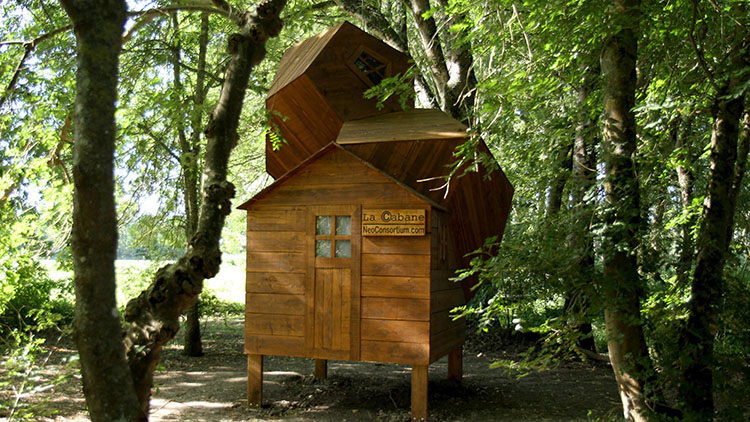
Danielle Gutman Hopenblum, ©abane du NeoConsortium, 2017.
To be interested in art is therefore to confront the political as in the legislature or, considering the practice of the Parisian artist Danielle Gutman Hopenblum, in the corporation. Since 2014, she has developed the spin of a fictional multinational: NeoConsortium. Having adopted the language of marketing, she claims to be the "Market leader in visual forms with high ubiquity". The form is thus considered as a solution to any kind of aesthetic problem. "Developed by the engineers of the Bureau of Polygons, Moduloform has become the flagship product of NeoConsortium": It is an assembly of irregular polyhedrons referring to both the origins of perspective and the computation of machines before they were capable of smoothing polygonal objects. And we understand, knowing the ambitions of NeoConsortium, that its headquarters have been moved to the moon. Unless it is for fiscal reasons, given its intense economic activity!
From game to participation

Anne-Marie Schleiner, B-Cities, 2007.
Today, it is within video games that we experience stories. At the edge of this dynamically flourishing field, an experimental branch has developed, as was the case for cinema. It is in this context of independence that Anne-Marie Schleiner has developed artist games in the same vein as artist books. Like B-Cities, from 2007, a creation that is played without the real intention of winning, the development environment is as important as the experience of the game itself. Especially when it comes to using it to make open-source applications. The games of this American artist have a before - when she appropriates open-sources previously developed - and will possibly have an after should others, as is so common these days, appropriate them in turn. In its very active international community - remember that the sphere of open-sources has benefited greatly from the development of the Internet - Do It Yourself (DIY) is just as essential as Do It Together (DOT). The fact that we can each one of us spend a bit of time in creating our own video games, but without any real investment other than using a computer, as Anne-Marie Schleiner demonstrates, is not negligible. In doing so, we participate in moving the lines separating the designers on the one hand and the gamers on the other hand. So that all of us become the actresses and actors of our simulated lives as well as our real lives.
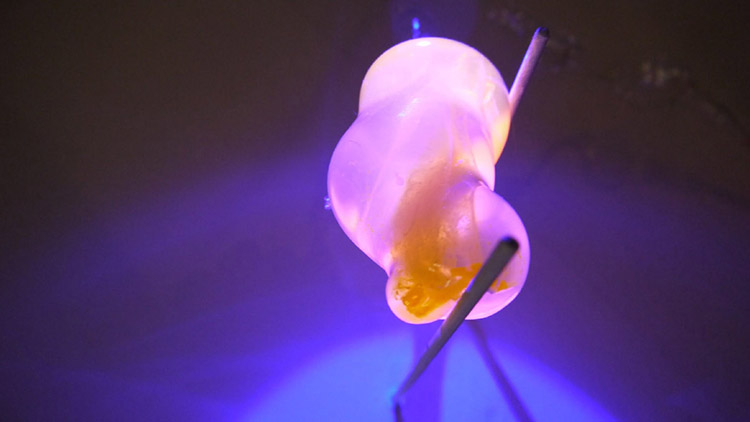
Pepa Ivanova, Decay, 2018-2019.
Participation was at the centre of Pepa Ivanova's practice when she created An Evolution Game in 2018. This is still a game, but one that is practiced in the tangible space of its presentation. Anyone can freely move objects around, most of which are plastic, that are attached to a grid that serves as a staging. This is where the notion of evolution symbolically comes into play when we question our responsibility for the mutation of this ecosystem simulation. The Brussels artist is also interested in the living when, in the same year, she designed the installation Decay, which implements biological dyes of animal or vegetable origin. The idea is that the dyes mingle, losing their initial colours in front of the eyes of spectators who cannot in any way act upon the engaged process of a life seeming to fade. This helplessness can only remind us of our very real responsibilities for our ecosystem.
The living

Marie-Eve Levasseur, An Inverted System to Feel (your shared agenda), 2016.
At the crossroads of the living and technology, there is the artistic project of a speculative design An Inverted System to Feel (your shared agenda) by Marie-Eve Levasseur, who lives and works in Leipzig. Dating from 2016, the installation is based on a three-dimensional sequence evoking the possible uses of our skin if it were transformed into a touch screen. Note that transhumanists are already dreaming of invading our bodies with connected nanoparticles. Thus augmented, we could then change colour according to our emotions or emergencies, which could save lives! But what about our privacy in this future where our skins would be programmable, given protecting our personal data is already difficult enough? Should we ensure that no one can "have our skin" by reprogramming it? There are more and more companies, using innovative technologies well beyond the control of States, who are predicting a "better world".
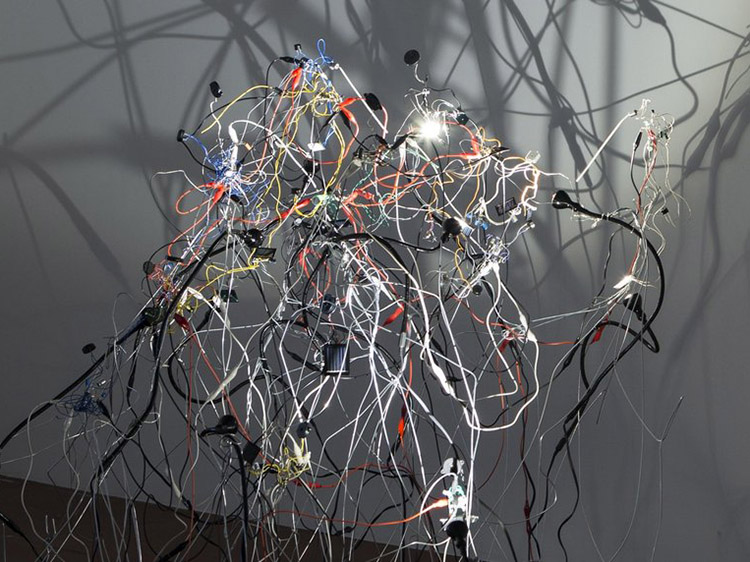
Katerina Undo, Creatures Cluster, 2014, photo Kristof Vrancken).
We naturally associate life with movements and sounds. And many artists, like Katerina Undo based between Athens and Brussels, simulate it, focusing on what represents it. Creatures Cluster from 2014 is a kinetic and sound installation that adapts to the places of its presentations while placing the public into the environment of a reconstituted nature. The tiny robotic creatures powered by solar cells inhabiting it are autonomous in their behaviour. The richness of the music of the sounds that emerge is the measure of the possible associations between congeners of a creative electronics. The living, here, is considered as a model of autonomy whose extreme diversity is a consequence of the combinatorics that has inspired so many scientists, for whom serendipity, or happy chance, is the other essential component.
In other territories

Laura Colmenares Guerra, Lagunas, 2017.
The cinema of Laura Laura Colmenares Guerra, with respect to her film Lagunas of 2017, is extended in space as in time in that it is in the form of a triptych and the public intervenes upon its screening. The Brussels artist makes us travel elsewhere through a landscape of mountain and water in their raw states in order to bring us back to the here and now, because the theme of the film refers us to our too frequent inability of associating ecology and economy. The subject in these territories where nature is protected, is fracking, whose damage to water, so dear to life, is very familiar to us. In order to emphasize our collective responsibility, the interface allows us to act on the screening consisting of industrial valves. The dramatic tension that sets in, thanks to a drivingly repetitive music, perfectly illustrates the political tensions that the extraction of shale gas generates.

Naziha Mestaoui , Sounds of light, 2013.
Water is again the focus in the forms of the sound and light installation Sounds of light (2013) by Naziha Mestaoui. She has recorded a sacred song from the Amazon that allows her to activate the liquid part of her installation. The frequencies of the words that follow each other draw geometric patterns on the surface. It is a completely universal abstract spectacle that is magnified via a projected image. Recalling that the human body is mainly made up of water, the Belgian artist draws our attention to the fact that the action of this same song - of which we know very little other than its sacredness - cannot be limited to acting only on the visible, liquid part of the installation. In seeing already what corresponds to the frequency, to what we hear, it is more than likely that the sacred message is also addressed to the body, in its part equally liquid, although invisible. For those who live the experience, it summons the very idea of shamanism.
Into the invisible
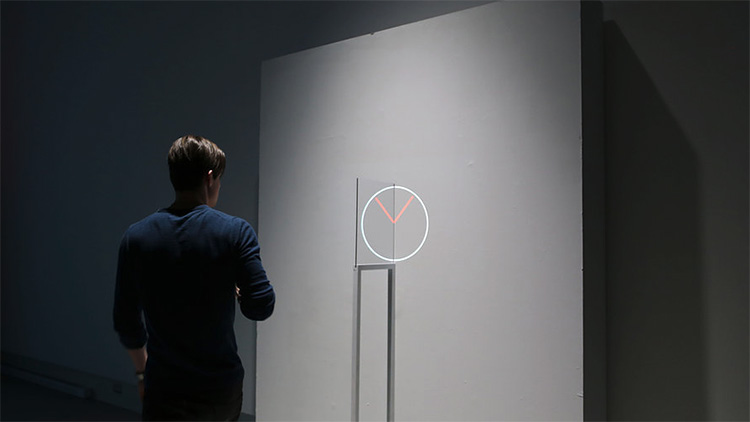
Cinzia Campolese, Frame of Reference, 2018 (photo Perte de signal).
The relationship of the visible to the invisible is a transhistorical theme that artists, like Cinzia Campolese, who approaches it by acting on our perceptions. With her kinetic installation Frame of Reference from 2018, the artist based in Montreal presents a form of symmetry whose imperfection makes us doubt. Because what appears to us totally symmetrical at first glance in a geometric animation partially reflected in a mirror is actually not quite so. The most disturbing in the circular movement with no real beginning or end, lies in the fact that the work refuses us the time to verify any hypotheses. The unstable equilibrium of this installation encourages us to observe it in its entirety without being attached to details, while getting used to the idea that this element of mystery is even more beautiful. That is to say, when we finally appreciate the imperfections that embellish it.

Myriam Bleau, Ballistics, 2019 (source La fabrique culturelle).
Finally, we end with Myriam Bleau whose performance of lights and sounds, Ballistics from 2019, mobilizes the body acting on pendulums. Everything is played in the long run where the pendulums, which can be compared to both musical instruments and instrumentalists of an orchestra, oscillate autonomously to return to their position of balance. The composer and performer, who lives and works in Montreal, moves in the space of her composition. Her intervention is part of a form of choreography that inevitably incorporates a part of improvisation. When she seizes a pendulum and does not let it go for a lapse of time, it seems to reveal sounds that were there in space, something like a sculptor bringing shapes to life by cutting away blocks of matter. Although it is in the invisible that Myriam Bleau acts during this performance, whose title refers us to a scientific measuring instrument summoning the laws of physics.
Beyond the genre that brings them together, the common point in the practices of all these artists lies in their use of techniques or technologies of yesterday and today to seize issues that are timeless or inherent to our time. The idea, always, is to give us readings of fragments of the world through attitudes and forms. It is the attitudes of these women artists that continue to become form in a changing society.
Articles
- Paris Photo
- Art, technology and AI
- Immersive Art
- Chroniques Biennial
- 7th Elektra Biennial
- 60th Venice Biennial
- Endless Variations
- Multitude & Singularity
- Another perspective
- The Fusion of Possibilities
- Persistence & Exploration
- Image 3.0
- BioMedia
- 59th Venice Biennale
- Decision Making
- Intelligence in art
- Ars Electronica 2021
- Art & NFT
- Metamorphosis
- An atypical year
- Real Feelings
- Signal - Espace(s) Réciproque(s)
- On Combinations at Work
- Human Learning
- Attitudes and forms by women
- Ars Electronica 2019
- 58th Venice Biennale
- Art, Technology and Trends
- Art in Brussels
- Plurality Of Digital Practices
- The Chroniques Biennial
- Ars Electronica 2018
- Montreal BIAN 2018
- Art In The Age Of The Internet
- Art Brussels 2018
- At ZKM in Karlsruhe
- Lyon Biennale 2017
- Ars Electronica 2017
- Digital Media at Fresnoy
- Art Basel 2017
- 57th Venice Biennial
- Art Brussels 2017
- Ars Electronica, bits and atoms
- The BIAN Montreal: Automata
- Japan, art and innovation
- Electronic Superhighway
- Lyon Biennale 2015
- Ars Electronica 2015
- Art Basel 2015
- The WRO Biennale
- The 56th Venice Biennale
- TodaysArt, The Hague, 2014
- Ars Electronica 2014
- Basel - Digital in Art
- The BIAN Montreal: Physical/ity
- Berlin, festivals and galleries
- Unpainted Munich
- Lyon biennial and then
- Ars Electronica, Total Recall
- The 55th Venice Biennale
- The Elektra Festival of Montreal
- Digital practices of contemporary art
- Berlin, arts technologies and events
- Sound Art @ ZKM, MAC & 104
- Ars Electronica 2012
- Panorama, the fourteenth
- International Digital Arts Biennial
- ZKM, Transmediale, Ikeda and Bartholl
- The Gaîté Lyrique - a year already
- TodaysArt, Almost Cinema and STRP
- The Ars Electronica Festival in Linz
- 54th Venice Biennial
- Elektra, Montreal, 2011
- Pixelache, Helsinki, 2011
- Transmediale, Berlin, 2011
- The STRP festival of Eindhoven
- Ars Electronica repairs the world
- Festivals in the Île-de-France
- Trends in Art Today
- Emerging artistic practices
- The Angel of History
- The Lyon Biennial
- Ars Electronica, Human Nature
- The Venice Biennial
- Nemo & Co
- From Karlsruhe to Berlin
- Media Art in London
- Youniverse, the Seville Biennial
- Ars Electronica, a new cultural economy
- Social Networks and Sonic Practices
- Skin, Media and Interfaces
- Sparks, Pixels and Festivals
- Digital Art in Belgium
- Image Territories, The Fresnoy
- Ars Electronica, goodbye privacy
- Digital Art in Montreal
- C3, ZKM & V2
- Les arts médiatiques en Allemagne
- Grégory Chatonsky
- Le festival Arborescence 2006
- Sept ans d'Art Outsiders
- Le festival Ars Electronica 2006
- Le festival Sonar 2006
- La performance audiovisuelle
- Le festival Transmediale 2006
- Antoine Schmitt
- Eduardo Kac
- Captations et traitements temps réel
- Maurice Benayoun
- Japon, au pays des médias émergents
- Stéphane Maguet
- Les arts numériques à New York